Career interview: The fastest mathematician on Earth
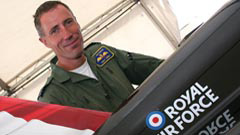
Andy Green.
Imagine hurtling through the desert at 1000mph in a rocket powered car, far outstripping the speed of sound, only to emerge, "shaken, deafened and cooked," as the fastest human being on land. Andy Green, Royal Air Force fighter pilot and Oxford maths graduate, is currently gearing up for just this experience, for the second time around. In 1997 Green was the first to break the sound barrier on land in his car Thrust SSC, reaching a speed of 763mph and setting the current land speed record. Now Green and his team are developing Bloodhound SSC, a super sonic car designed to reach 1000mph. It's destined to hit a desert surface in around two years' time, with the aim of breaking Green's own record.
"We've been working on the project for about two and a half years now," says Green. "We're just coming to the end of the design phase, so we can fix the exterior shape, and the basic layout of the major components. It's a very exciting time. After two and a half years of theoretical effort, we're just about to start making the car, it's all coming together really fast."
The driver
If, like me, you thought that driving a supersonic car is a bit like driving to work, only a lot faster, then think again. The immense acceleration, from 0 to 1000mph in a predicted 40 seconds, will subject Green to a g-force close to that experienced by dive-bombing fighter pilots, around -2.5g — it's a negative g-force because Green is travelling feet first. The subsequent deceleration, due to Green breaking by shutting down a combined 21 tonnes of thrust from the rocket and jet that are powering the car, will reach up to 3g. "If you haven't trained for it, this can make you pass out right there," says Green. "That's one of the things I'm going to have to compensate for, as well as being in a very hot cockpit and a high vibration and high noise environment." Apart from the physiological demands, there's the brain strain: "The driving is the easy bit. It's a prototype vehicle, so I'm going to be monitoring the jet, the rocket performance, the temperatures and pressures, the wheel loads, the stability of the car, and more. If something goes wrong, we can shut the rocket down very quickly, within a few hundred milliseconds, but we need to be able to see that coming."
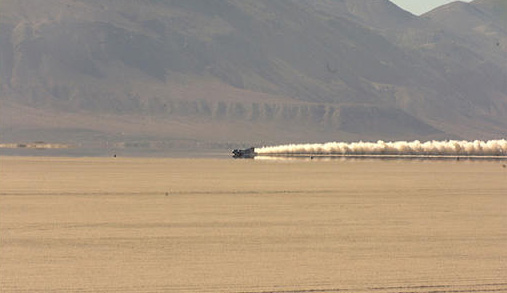
Andy Green breaking the land speed record in Thrust SSC in the Black Rock Desert, Nevada, in 1997. Photo: Jeremy Davey © SSC Programme Ltd.
Green's training as a pilot and, perhaps surprisingly, his maths background made him a perfect candidate for the driver role. Flying not only involves supersonic speeds, but also the ability to multitask — leading a formation, talking on the radio, navigating, looking at the radar, all at the same time. "[During my flying training], I fell back on the mathematical disciplines," says Green, "analysing all I was trying to do, analysing all of the inputs, and the amount of resource each task would take. I actually had a time sharing algorithm, taken straight out of the 'how to fly an aeroplane' book, and I was incredibly disciplined at applying it. Having a disciplined mind to approach the background routine tasks of flying gave me enough capacity to address the problem areas, and that's how I got through flying training. I didn't need detailed maths to understand aeroplane flying, but I did need the mental discipline to analyse the tasks and do them in real time."
Green's interest in maths started when he was at school. "I always had a scientific bent. While I could do English, I hated writing essays — it was just too time consuming and laborious. But I thoroughly enjoyed the purity of mathematics." He went on to study mathematics at Oxford, on a cadetship sponsored by the Royal Air Force, and after that went straight into flying training. "I've been flying for the Royal Air Force for over twenty years now, and it's just the best job I could ever possibly have had. [My university maths] has been massively useful, from understanding the detail of what makes aeroplanes work and how they fly, to the sort of analysis I'm doing in my job right now, which is looking after operations policy. For example, the accuracy and repeatability of aeronautical information, the supply to aeroplanes, and the integration of electronic systems — these are not mathematical problems, but working out what you need, how to specify it, and what it costs requires exactly the same kind of analysis as a mathematical problem."
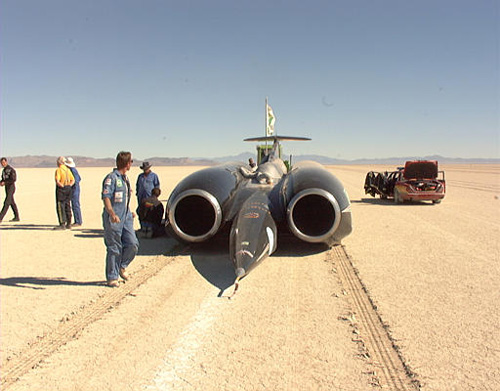
Thrust SSC in the Black Rock Desert, Nevada, in 1997. Photo: Jeremy Davey © SSC Programme Ltd.
When Green saw in 1994 that the team building the first supersonic car, Thrust SSC, were looking for a driver, he figured that he had just the qualifications they needed. He applied and beat 15 other candidates to the job, and eventually bagged the land speed record in 1997. With Thrust SSC, as well as the current project Bloodhound SSC, Green's background puts him in an unusual position for a driver, in that he's taking an active part in the design and construction of the car. "I can understand how to simulate what the airflow is going to do [at a particular speed], right through to the sequencing, millisecond by millisecond, of how we wind up the rocket, how that is going to affect the dynamics of the body, and how I input into that as a driver by steering and throttle inputs." It's an unusual position for a driver to be in, because these days it's usually the car, rather than the driver, that gives engineers vital feedback through a huge number of readings taken by sensors during test runs.
The car
Bloodhound SSC — vital statistics
Predicted Mach number: up to Mach 1.4
Length: ca 13m
Weight: ca 7 tonnes
Powerplants: Falcon hybrid rocket and Eurojet EJ200 jet engine
Auxiliary power unit: MCT V12 800 bhp race engine. Delivers auxiliary power to start the jet engine and to deliver fuel to the rocket
Rocket fuel: High Test Peroxide (HTP) as the oxidiser and HTPB, an aromatic rubber substance, as the fuel
Jet fuel: standard jet fuel
Bloodhound SSC will be powered by a hybrid rocket and a Eurojet EJ200 jet engine, normally used on Eurofighter Typhoon aircraft. The rocket provides raw power, while the fully controllable jet engine allows careful regulation of the combined output of rocket and jet. This sensitivity is essential, as at these high velocities you need to tread carefully, increasing the speed only gradually at each test run. The goal is for Bloodhound to reach a top speed of 1000mph. The speed of sound is around 760mph, but it varies with temperature. To get a direct relationship between the two, engineers look at the Mach number, the ratio between the speed of the vehicle and that of sound in the particular conditions of the day. Bloodhound is designed to withstand Mach numbers of up to 1.4. Thrust SSC managed Mach 1.02, 2% above the speed of sound. (See the Bloodhound website for more technical information on the car.)
The trickiest challenge facing the the Bloodhound engineering team, led by John Piper and Ron Ayers, is the car's shape. "The problem is to keep the car on the ground through the whole speed range and with all the dramatic airflow," says Green. "What looks like the optimum shape at Mach 1.3, produces so much down force at Mach 0.5 to 0.7, because of the accelerated airflow under the vehicle, that it's too much for the suspension to cope with. If we get rid of that down force, we finish up with too much lift at Mach 1.3, and the back end of the car comes off the ground. These are mutually exclusive requirements. No-one has ever found an aerodynamic shape that will stay on the ground through the whole speed range, but we're converging on a solution — we're just tweaking the edges."
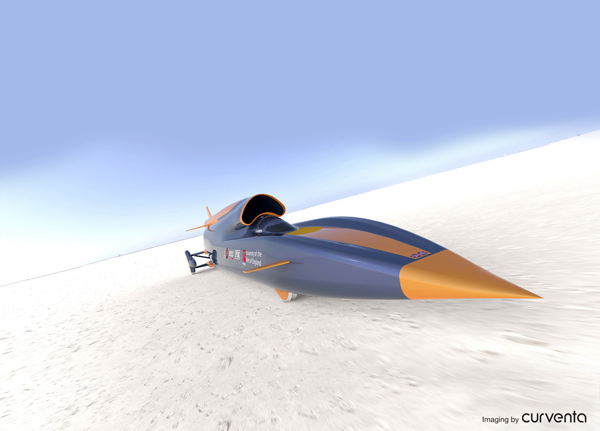
A model of Bloodhound SSC. Image courtesy curventa.
Apart from its pencil shape the most noticeable feature of Bloodhound are the back wheels, which are positioned on struts at the back end of the car to ensure stability. Aerodynamically, this is a disadvantage. "The struts cause a shock wave, a deceleration," says Green, "deceleration of airflow equals an increase in pressure, which at supersonic speeds lifts the back end of the car off the ground. One solution is, instead of trying to soften the shock wave, to make it as hard as possible, so that we have to manage only a single shock wave instead of lots of them. Or, move the wheels even further back so that the high pressure region is mostly happening behind the car. But this subjects the wheels and suspension to unimaginably high vibration and acoustic loads — can you actually make precision components function in that kind of destructive environment? That's the challenge now: if we move the wheels back, do we have a physical problem that no metals in the world can solve? Or do we have to move the wheels forward and find an aerodynamic solution?"
It may come as a bit of a shock to hear that, at this stage, no functioning physical model of the car exists. At the moment Bloodhound is a completely virtual entity whose various aspects are being simulated on super computers, specially built for the purpose. In fact, it was Green and the Thrust SSC team who pioneered the use of computer modelling in this area fifteen years ago. "Wind tunnels were not an option," explains Green. "You can have a supersonic wind tunnel giving you flow over the top of the car, but you can't simulate the flow underneath the car, because the ground has to go past at the same speed as the wind. So now you need a supersonic conveyor belt, and that's impossible." The team instead turned to the Navier-Stokes equations, a set of complex differential equations which describe air flow. In most real-life situations, as in this one, it's impossible to solve these equations analytically. But with the help of powerful computers, you can employ some educated guesswork to come up with approximate solutions that tell you just how the air will behave. The branch of maths that develops the computer algorithms for this task is called computational fluid dynamics. It requires massive amounts of computing power, but comes up with effective results.
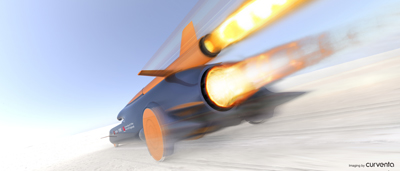
A model of Bloodhound SSC seen from the rear. Image courtesy curventa.
"Fifteen years ago computational fluid dynamics offered a solution, but nobody had ever used it for this before," says Green. "Most people were enormously sceptical, understandably, about computer modelling. So we built a scale model of the car, fired it down a test track and measured the airflow underneath it. There's a supersonic weapons test track in South Wales, which we used for the best part of eight weeks to gradually build up the test profiles. We took the data from the model, made the scale corrections, and compared it to the predictions of our computer model. The two sets of data were almost identical across the whole speed range. A totally practical scale model versus a totally theoretical computer model — if they agree across a whole range of data points with very high correlation, then both models have to be right. So we had validated the principles of computational fluid dynamics modelling for a supersonic vehicle. All we're doing now is reaping the benefits of fifteen years of computer development, so we can do it to a much higher level of accuracy." (See the Plus article Supersonic Bloodhound to find out more about computational fluid dynamics applied to Bloodhound.)
If you're imagining a Bloodhound computer model to look a bit like a Formula One computer game, you're wrong, but not that wrong. A whole range of things are being simulated in separate models — from the handling of the car to the catalyst pack (which, incidentally, is the largest in the world). "There is no computer in the world that could run all the models together," says Green, "the aerodynamics model alone required us to build one of the biggest computer suites in the country, down at Swansea University. But taking different pieces of results it's relatively easy to build simulators. Either to entertain the public, or to allow me to do some detailed cockpit development and instrumentation design, so that I'm not trying to move three switches and look at three dials at the same time. We'll be doing detailed simulations all the way through." The team is hoping to start building the car later this year. Four UK cities are currently bidding to host the project.
The desert
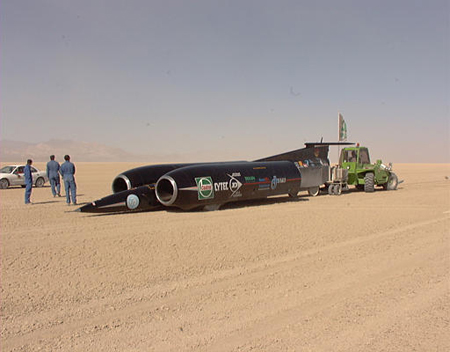
The Black Rock Desert in Nevada was deemed just right for Thrust SSC. Photo: Jeremy Davey © SSC Programme Ltd.
But it's not all about engineering. Another challenge not to be sniffed at is finding the perfect desert for Green and Bloodhound to attempt their record. But why a desert and not a road? "If you can find us a road that's perfectly flat — since even a 10mm bump is massive at these speeds — in excess of 20km long, and several hundred metres wide — as you can't guarantee to keep the car on the centre line if there's a gust of cross wind — then the only other problem you need to solve is what sort of tires could run on it." You'd need something somewhere near the limiting strength of titanium. "If you run on titanium discs on a tarmac surface, you have no grip whatsoever. Even the tiniest bump will cause the wheel to leave the surface. Then you cease to be a car and you don't get the record. This is why running on a mud surface is so useful. We're only cutting ruts a few millimetres deep, but it's deep enough to allow the suspension some latitude in which to work, so as the car does hit bumps, the wheels remain in contact with the surface. Then you're a car in the dynamic sense, which makes things safer, and in the technical sense, so you can get the record."
The team did a search of every flat area on Earth, using, unsurprisingly, a computer algorithm. It compares a space shuttle radar survey of the planet with some near infra red satellite imagery. The area needs to be flat of course, but also dry and have little vegetation. "We started with several thousand options, shortlisted 36 of them, and we're now down to the last three. I've been to all three and we're doing some detailed tests to find out which one, or two, we want to run on."
The point
If you're not naturally enthused by this kind of project, you're probably wondering what the point is, besides spending money and environmental resources. But Green emphasises the research output, which, he says, is eagerly anticipated by scientists around the world. The aerodynamic aspect of the project, keeping the car on the ground through the whole speed range, is funded as a three-year research programme at Swansea University, which was also involved in the Thrust SSC project. The results will make it into the public domain via research publications, thus benefiting the wider scientific community.
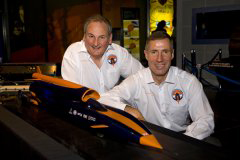
Richard Noble, Bloodhound project director, and Andy Green, with a model of Bloodhound.
More importantly, the project comes with an extensive education programme. "We are producing education packages that slot straight into maths, engineering, and technology teaching programmes across the country," says Green. "We want to try and make maths and engineering fun, not just for 15 year-olds, but also 7 and 8 year-olds. When we start building the car there will be a visitors' centre with a walk way into the workshop, so that we can not only meet the visitors, but also let them see the world's fastest car being built. We're aiming to put coach loads of school students through the visitor centre every day." You can sign up to the resources for free on the Bloodhound SSC website, which will also keep you up to date with Bloodhound's progress.
Inspiring the next generation of engineers and mathematicians is one of the main aims of the Bloodhound project. Engineering, like maths, has been suffering an image crisis in recent years, leading to a drop in the number of students taking it at university and fears about the UK's ability to compete internationally in the future. Green certainly doesn't conform to the stereotypical image of the boring engineer wandering around with a measuring tape. And behind the simple attempt to break a record lies a fascinating engineering adventure that requires creativity, brains, guts, and lots of sound human judgment. If Bloodhound does manage to draw more young people into engineering and science, then it will have been worth the effort, and the money.
About the author
Andy Green was interviewed by Marianne Freiberger, Co-Editor of Plus, in London in July 2009.